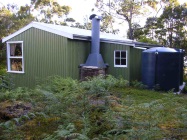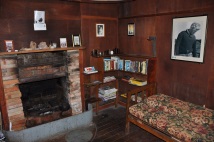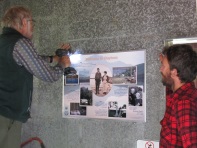Claytons Corner Melaleuca
Where Melaleuca Inlet broadens into Forest Lag before flowing into Bathurst Harbour, there is a quiet nook called Claytons Corner. A jetty there is a favoured refuge from the ‘Roaring Forties’ for small yachts and fishing boats, and a little up the bank a small cottage is hidden among the trees. The cottage snuggles next to a slope swathed in rainforest. Win and Clyde Clayton remembered this sheltered nook when weather forced them to move house from the northern arm of Port Davey in 1962. In fact, Win had had her eye on the place since the 1940s. Back then, in a rowing punt, she used to visit what the King family called ‘The Big Scrub’, with her father Charlie and brother Deny King. Clyde Clayton, the fisherman who brought the mail and stores to the little tin-mining outpost at Melaleuca, was smitten at his first sight of Win. They were married in 1948, and Win’s adventuresome life continued . They lived on the fishing boat for the first few years, and then built a little home at Bond Bay on the northern side of Port Davey. This was a pretty spot, but a bad anchorage in a southerly – hence the move in the early 1960s. This was necessarily a do-it-yourself exercise, with the house taken apart bit by bit and transported to the new location on the deck of their fishing boat. It was not long before this spot became known as Claytons Corner.
. They lived on the fishing boat for the first few years, and then built a little home at Bond Bay on the northern side of Port Davey. This was a pretty spot, but a bad anchorage in a southerly – hence the move in the early 1960s. This was necessarily a do-it-yourself exercise, with the house taken apart bit by bit and transported to the new location on the deck of their fishing boat. It was not long before this spot became known as Claytons Corner.
After fourteen years at Claytons Corner, Win and Clyde retired in 1976 to live in le ss remote parts of the state, and their cottage was purchased by Parks and Wildlife Service. The house in time deteriorated in the damp climate, and was restored with a lot of hard work by Friends of Claytons in partnership with PWS during a number of working bees. Friends of Melaleuca then took up the project, and we have repaired, painted and scrubbed, lopped and dug at Claytons during working bees over the past few years.
ss remote parts of the state, and their cottage was purchased by Parks and Wildlife Service. The house in time deteriorated in the damp climate, and was restored with a lot of hard work by Friends of Claytons in partnership with PWS during a number of working bees. Friends of Melaleuca then took up the project, and we have repaired, painted and scrubbed, lopped and dug at Claytons during working bees over the past few years.
FoM’s latest undertaking at Clayton’s is ‘the icing on the cake’. With the help of a grant from Wildcare, we produced  eight display panels depicting Win and Clyde’s story during their time at Claytons Corner. Having written Win and Clyde’s biography a few years ago, I had a good collection of photos
eight display panels depicting Win and Clyde’s story during their time at Claytons Corner. Having written Win and Clyde’s biography a few years ago, I had a good collection of photos and information to draw on for this work.
and information to draw on for this work.
An introductory panel hung in the entry sets the scene. Portraits were a priority of course , and we chose to hang these in the living room. Clyde had a passion for old wooden boats, so photos of the four boats that he owned as a professional fisherman made an important theme for another panel. Win was a keen gardener, a passion that did not always go well with seafaring. Nevertheless she managed to create an amazing garden. With th
, and we chose to hang these in the living room. Clyde had a passion for old wooden boats, so photos of the four boats that he owned as a professional fisherman made an important theme for another panel. Win was a keen gardener, a passion that did not always go well with seafaring. Nevertheless she managed to create an amazing garden. With th e help of photos, and from my sister Mary who has a prodigious memory for plants, we were able to draw a plan view of the garden. This is the central feature of a panel, and is surrounded by photos of Win’s flowers. Another panel tells the ‘piano story’, a favourite of readers of King of the Wilderness and Win
e help of photos, and from my sister Mary who has a prodigious memory for plants, we were able to draw a plan view of the garden. This is the central feature of a panel, and is surrounded by photos of Win’s flowers. Another panel tells the ‘piano story’, a favourite of readers of King of the Wilderness and Win and Clyde and tells the chequered adventures of Win’s piano – bushfires, sea voyages and the like. Other panels tell of the Whalers Point navigation light that Clyde erected and serviced for many years, and of the pygmy possums that shared
and Clyde and tells the chequered adventures of Win’s piano – bushfires, sea voyages and the like. Other panels tell of the Whalers Point navigation light that Clyde erected and serviced for many years, and of the pygmy possums that shared the house with the Claytons.
the house with the Claytons.
Producing these panels entailed many drafts, changes of mind and much editing and input from various members of FoM. Due to funding constraints, graphic design was not done by a professional contractor. Hence it took an inordinate amount of time on account of inexperience and low-end software. Our printer was bene
of inexperience and low-end software. Our printer was bene volence personified, wrangling with our files with barely a groan, and printing the panels as a donation. Richard Blundell had sailed to Port Davey in the past and remembered Win and Clyde. He is also the man at the helm of Pumpkin Prints which handles contracts for Wildcare branded clothing. Our heartfelt thanks go to Richard.
volence personified, wrangling with our files with barely a groan, and printing the panels as a donation. Richard Blundell had sailed to Port Davey in the past and remembered Win and Clyde. He is also the man at the helm of Pumpkin Prints which handles contracts for Wildcare branded clothing. Our heartfelt thanks go to Richard.
The images were printed on aluminium composite panel. This consists of two thin sheets of aluminium with a foam core sandwiched between. It is robust stuff, stands up to damp conditions and is easily cleaned, while being less expensive than printing on plain aluminium sheet. The printing came out well.
We hoped to recreate a domestic ambience in the Claytons house, and to that end decided to frame the panels. Thanks to the Maritime Museum of Tasmania for donating the neat black frames for three of the panels and to Geoff Fenton for doing a neat ‘cut and shut’ job on those plus framing the introductory panel with aluminium strips. The four larger panels in the house we had professionally framed by Wagner Framemakers who were very helpful and interested in the project.
on those plus framing the introductory panel with aluminium strips. The four larger panels in the house we had professionally framed by Wagner Framemakers who were very helpful and interested in the project.
Since we hung the panels during the summer, we have had some great feedback from visiting tourist groups and yachting visitors. And we keep thinking of other ideas to add to the homeliness of the place and to the visitor experience. We have added some small mantel-piece photos in frames, some issues of Win and Clyde’s favourite magazines, National Geographic and Your
in frames, some issues of Win and Clyde’s favourite magazines, National Geographic and Your Garden dated during the period of their occupancy, and a folder with additional information. There are other ideas, such as facsimiles of old visitors’ books. Ranger Ian Marmion even suggested installing
Garden dated during the period of their occupancy, and a folder with additional information. There are other ideas, such as facsimiles of old visitors’ books. Ranger Ian Marmion even suggested installing an old piano. Well, why not? It’s been done before!
an old piano. Well, why not? It’s been done before!
I remember back in the 1960s and early ’70s calling in at Claytons Corner for a cup of tea and scones, hot from Win’s Rayburn, or staying the night, listening to long yarns by the fire in the evenings. It is great to see the house warming with memories again, and Win and Clyde’s portraits looking down on us in the living room. We are pleased that the many tourist groups and boating visitors can now appreciate the lives of those who created this little home in the wilderness.
the lives of those who created this little home in the wilderness.
Janet Fenton